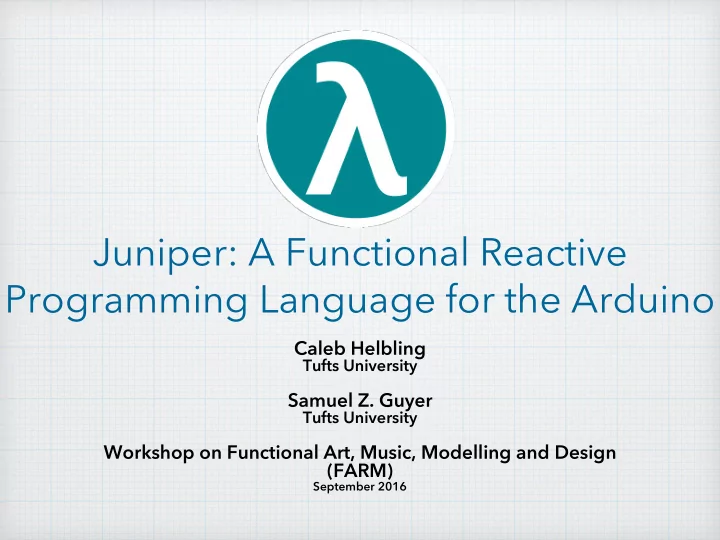

Juniper: A Functional Reactive Programming Language for the Arduino Caleb Helbling Tufts University Samuel Z. Guyer Tufts University Workshop on Functional Art, Music, Modelling and Design (FARM) September 2016
Project Ideas
From the Arduino Web Site “ Simple, clear programming environment - The Arduino programming environment is easy-to-use for beginners , yet flexible enough for advanced users to take advantage of as well. For teachers, it's conveniently based on the Processing programming environment, so students learning to program in that environment will be familiar with the look and feel of Arduino” Nope
Surprise! It’s C++ (but it kinda needs to be)
Hello, blinky world! // -- Attach an LED to pin 13 int led = 13; // -- The setup routine runs once void setup () { // -- Initialize the pin for output pinMode(led, OUTPUT); } // -- Loop is called over and over forever: void loop () { void blink(int pin, int interval) digitalWrite(led, HIGH); { delay(1000); digitalWrite(pin, HIGH); digitalWrite(led, LOW); delay(interval); delay(1000); digitalWrite(pin, LOW); } delay(interval); }
Add a momentary button int buttonPin = 2; int ledPin = 13; bool ledOn = false; void loop (){ // —- Look for press if (digitalRead(buttonPin) == HIGH) { // -- Wait for button release while (digitalRead(buttonPin) != LOW) { } // -- Toggle LED on or off if ( ! ledOn) { digitalWrite(ledPin, HIGH); ledOn = true; } else { digitalWrite(ledPin, LOW); ledOn = false; } } }
Signal bounce
bool isPressed (int pin) { // —- Look for press if (digitalRead(pin) == HIGH) { Debounce // -- Wait 50ms delay(50); // -- Still pressed? OK, continue if (digitalRead(pin) == HIGH) { // Wait for the release void loop () while (digitalRead(pin) != LOW) { } { return true; if ( isPressed (buttonPin)) { } if ( ! ledOn) { } digitalWrite(ledPin, HIGH); return false; ledOn = true; } } else { Challenge: button digitalWrite(ledPin, LOW); turns blinking led ledOn = false; on and off } } }
Does this work? void blink (int pin, int interval) { digitalWrite(pin, HIGH); delay(interval); digitalWrite(pin, LOW); delay(interval); } void loop () Stuck waiting { if ( isPressed (buttonPin)) { for button release if ( ! ledOn) { ledOn = true; } else { ledOn = false; } } Stuck here for if (ledOn) { blink (13, 1000); 2 seconds! } }
uint32_t last_time_2 = 0; bool led_state_2 = false; This doesn’t work void blink(int pin, void loop () int interval) { { uint32_t curtime = millis(); digitalWrite(pin, HIGH); delay(interval); if (curtime - last_time_1 > 1000) { digitalWrite(pin, LOW); last_time_1 = curtime; delay(interval); if (led_state_1) } digitalWrite(13, LOW); else void loop () digitalWrite(13, HIGH); { led_state_1 = ! led_state_1; blink(13, 1000); } blink(9, 300); } if (curtime - last_time_2 > 300) { Even simpler: last_time_2 = curtime; if (led_state_2) blink two lights digitalWrite(9, LOW); at different intervals else digitalWrite(9, HIGH);
Functions that use delay() do not compose Combining concurrent activities requires explicit scheduling “Blinking” is an ongoing process Need composition in time A.k.a., concurrency
Any reasonably sophisticated software application for the Arduino consists of: ad hoc discrete event scheduler + finite state machine(s) Fairly advanced to implement
Our Approach Use Functional Reactive Programming to handle events/streams of events Use the “foldP” (fold over the past) FRP function to simulate state machines
FRP Classification Juniper is a higher-order discrete impure monadic FRP Language What this actually means: Dynamic signal graphs allowed Signals of signals are allowed Lose equational reasoning to avoid space leak No continuous signals
Language Features • Algebraic data types • Parametric polymorphic functions • Lambdas • Closures • Type inference • Limited dependent typing (size is part of an array type) • Pattern matching • Immutable data structures • Imperative features • Mutable references • Inline C++
Signal Graphs Events “flow” along signals or signals are time varying values Signals connected together form a directed graph
Signal graph representation 2 KB RAM à Not enough space to store the data structure itself + necessary runtime components One possibility: static signal graph known at compile time - use adjacency list Our approach: Signal graph embedded within the call graph
Signals in Juniper type maybe<'a> = just of 'a | nothing type sig<'a> = signal of maybe<'a>
Blinking LED in Juniper module Blink open(Prelude, Io, Time) let boardLed = 13 let tState = Time:state() let ledState = ref low() fun blink() = ... fun setup() = Io:setPinMode(boardLed, Io:output()) fun main() = ( setup(); while true do blink() end )
Blinking LED in Juniper module Io ... type pinState = high | low ... fun blink() = ( let timerSig = Time:every(1000, tState); let ledSig = Signal:foldP( fn (currentTime, lastState) -> Io:toggle(lastState) end, ledState, timerSig); Io:digOut(boardLed, ledSig) )
Compilation type maybe<'a> = just of 'a | nothing template < typename a > struct maybe { uint8_t tag ; bool operator==( maybe rhs ) { if (this-> tag != rhs . tag ) { return false; } switch (this-> tag ) { case 0 : return this-> just == rhs . just ; case 1 : return this-> nothing == rhs . nothing ; } return false; } bool operator!=( maybe rhs ) { return !( rhs == *this); } union { a just ; uint8_t nothing ; }; };
Compilation while true do ... end (([&]() -> Prelude :: unit { while (true) { ... } return {}; })());
Case Study: Digital Hourglass Rich Set of Behaviors • Program Mode • Timing Mode • Pause Mode • Finale Mode C++: 950 lines (and it required a lot of thought) Juniper: 350 lines (and it worked the first time)
Conclusion • Juniper is a new FRP language designed to be run on small microcontrollers like the Arduino • Has many functional programming features • Compiles to C++ • Shows clear benefits for logic re-use; specifically with time dependent behaviors Thank you! http://www.juniper-lang.org/
Recommend
More recommend